Early evening in downtown Asheville, North Carolina.
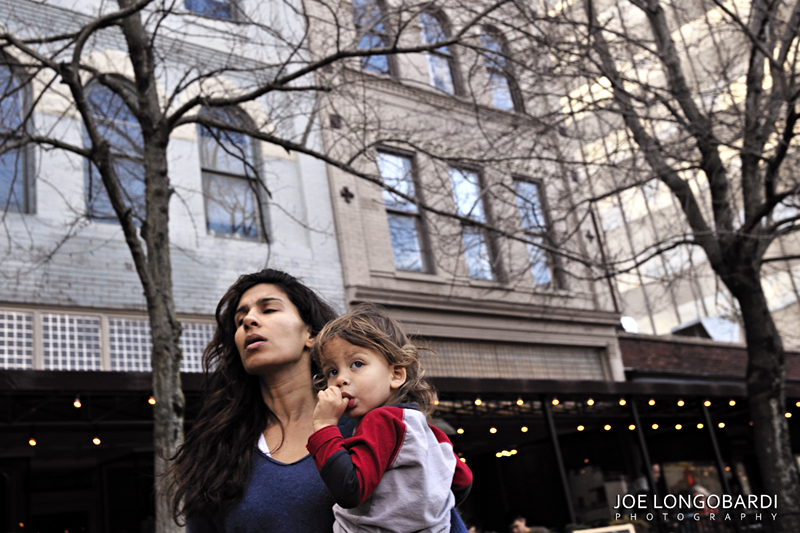
Mother and Child Reunion
All images © Joe Longobardi. All Rights Reserved.
joelongobardiphotography.com/
joelongobardiphotography.com/books

Early evening in downtown Asheville, North Carolina.

Mother and Child Reunion
All images © Joe Longobardi. All Rights Reserved.
joelongobardiphotography.com/
joelongobardiphotography.com/books
A series of images from FASHMOB IV held in downtown Asheville, North Carolina. Although the event revolved around the photographing of models and fashion apparel, these participating models offered up this rather intriguing tragic play for the benefit of the photographers who attended the event.
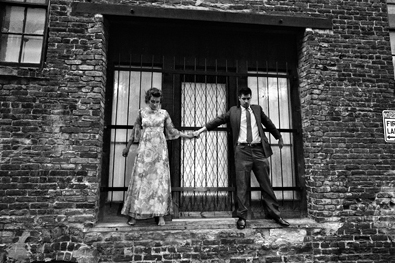
The lovers
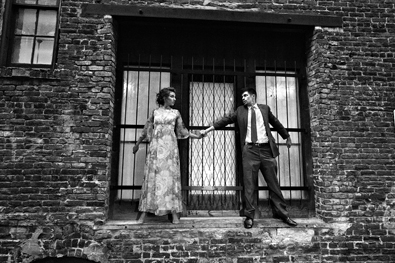
The gaze
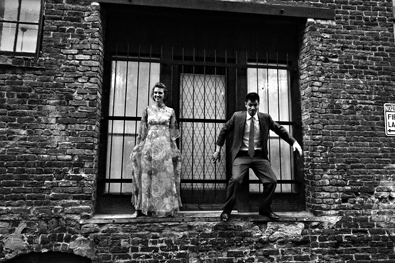
At the ready
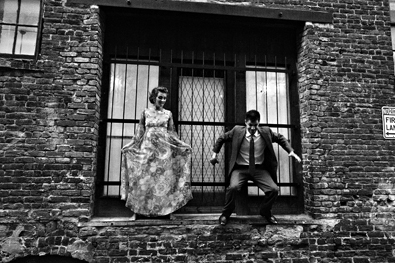
As she looks on
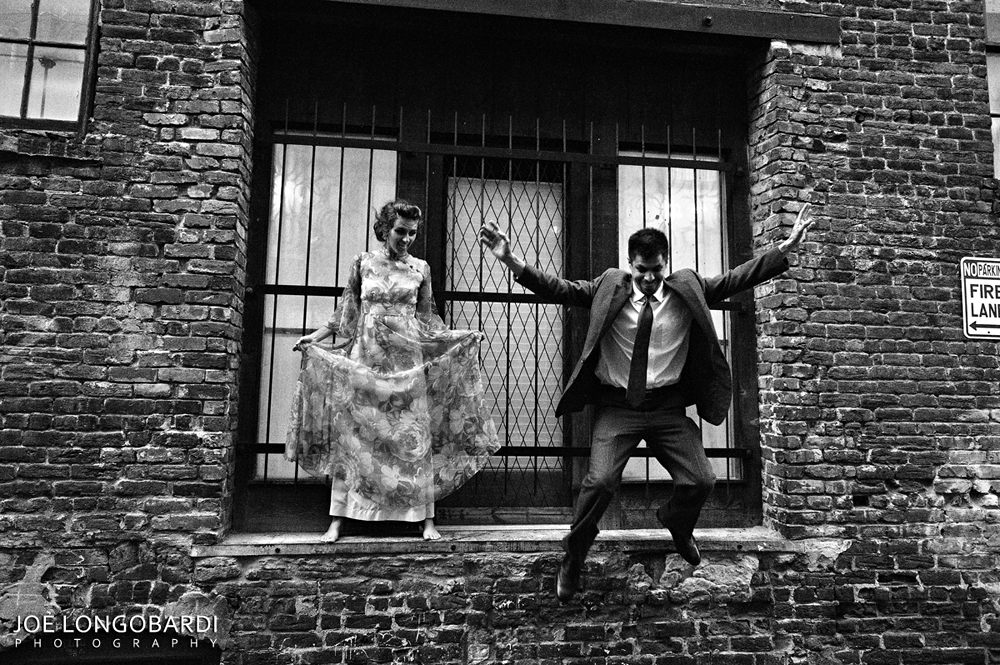
The leap
All images © Joe Longobardi. All Rights Reserved.
joelongobardiphotography.com/
joelongobardiphotography.com/books
Not all street life comes in flesh and blood.

Spirit
All images © Joe Longobardi. All Rights Reserved.
joelongobardiphotography.com/
joelongobardiphotography.com/books
This blog part of a series and accompanying introduction to a street photography event that will happen on June 19, 2015 in downtown Asheville, North Carolina. For more information visit Street Photography and the Summer Solstice on Facebook.
The 50mm lens is back!
First, let me start by stating that my lens of choice has currently been the 28mm, and just behind that the 35mm. They allow me to rely on such techniques as scale focusing, also know as zone focusing, at small enough apertures (f-stops) to maintain enough depth of field (also known by the acronym DOF) to keep my subject of interest in sharp focus. This comes in quite handy when shooting the fast pace of a city on the fly! People are constantly on the move, and even though a fast shutter can freeze the action, having a large depth of field is far more forgiving in keeping things in focus, even at slower shutter speeds. This larger DOF is also advantageous when the subject is moving towards or away from you and begins to move outside the area of best focus. Having that greater depth ensures that the moving object retains an acceptable level of focus and sharpness. Plus you can get in close to your subject while still taking in enough of the surrounding environment. There may be more information to compose correctly for the final image, but done just right it can have a very dynamic impact on the final result. Case in point, the following image was shot with a 28mm using scale focusing (zone focusing).
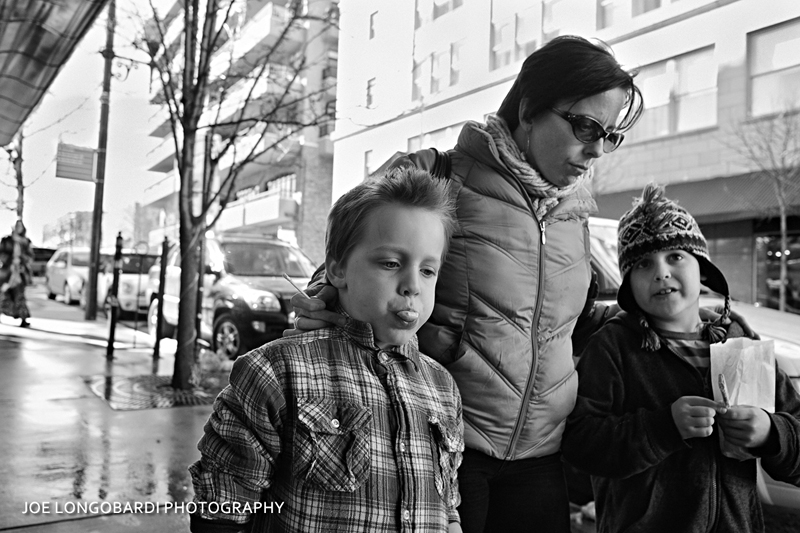
Shot from the hip with 28mm lens
And this was shot using a 35mm lens.
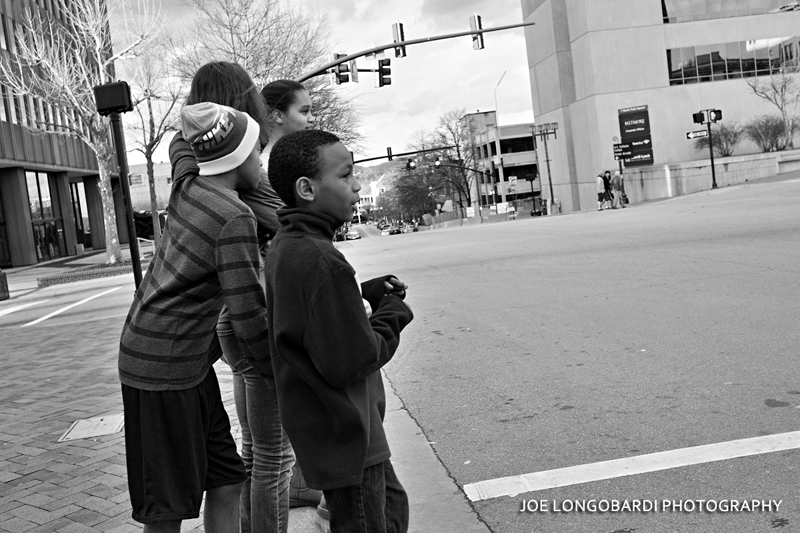
Kids crossing street. 35mm lens.
In both these instances I used a technique known as “shooting from the hip” where once I have my distance calculated via the distance scale on my lens (found on a manual or earlier auto focus lens, many modern digital no longer have aperture rings, so the distances are not marked on the lens), I can gauge how much depth of field I will have as I approach a subject moving towards me at a similar pace. And although I never lifted the viewfinder of the camera to my eye to frame this shot, the image more or less came out as I had anticipated. This of course was achieved through lots and lots of practice! In other words, I know how the lens will frame the content from certain angles such as waist or chest height. Over time, the lens becomes an extension of the body. Another very useful technique when shooting street photography incorporates focusing a lens such as the 28mm at its hyperfocal distance. This often achieves the best balance of sharpness from foreground to background.
But I find the 50mm is still the go to lens for when I need to take in information at such a hurried pace, and can’t move fast enough towards something of interest a distance away. The 28mm used for the first image above allowed me to get very close (about 4 feet away), and I still got a lot of information in the photo while keeping the subjects in focus. The 50mm lens on the other hand requires more “breathing space”, if you will. Not just because it’s longer requiring you to step back, but also as the focal length of any lens increases, images shot with a 50mm at the same f-stop and distance from subject as a shorter lens have less depth of field, and therefore less of the scene in focus. And of course, the longer the lens, the more narrow the field of view (FOV). A wide lens such as the 28mm can take in 300% more of a scene than a 50mm. Even a 35mm takes in approximately 200% more than it’s 50mm cousin.
Once a very popular general lens, over time, the 50mm prime was abandoned by many photographers. This was partly due to the increase in quality of zoom lenses that covered that focal length, but also as wider lenses became more in vogue with photojournalists and the public in general, the 50mm was seen as a very, well…boring lens. When digital cameras became the norm, most inexpensive sensors were smaller cropped versions (APS-C) of a 35mm equivalent, resulting in a narrow field of view similar to a telephoto or portrait lens of approximately 80mm. This was due to only a small center portion of the lens being utilized by the camera’s sensor. But with full frame digital cameras equivalent to 35mm film becoming more prevalent and more affordable to the consumer, and an added renewed interest in street photography, the 50mm has regained some of its past glory. One can now use it to its full potential rather than as the poor man’s portrait lens on a cropped DSLR sensor.
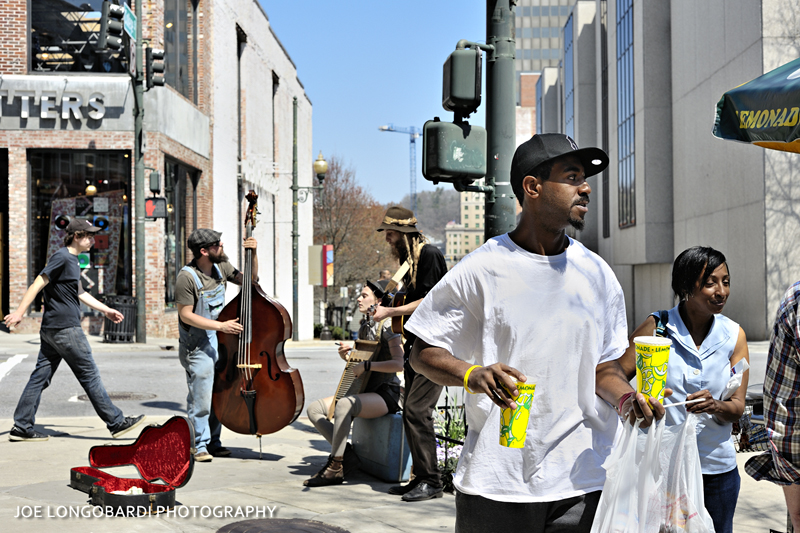
Lemonade, shot with 50mm lens shot at f/8
The French photographer Henri Cartier-Bresson (1908-2004) did most of his work with a 50mm lens, whereas the American photographer Garry Winogrand (1928-1984) used a 28mm for a good part of his life. I spent some time thinking about each photographer’s very distinct preferences. I concluded that since Winogrand prowled the narrow sidewalks of New York City, he resorted (like many of his contemporaries) to a short focal length to get in everything that he was seeing in his field of view. A 50mm lens would be just too long to pull this off in a narrow working space of 4 to 10 feet. Plus, Winogrand liked to get in on the action. Bresson on the other hand was very stealth in his approach and liked to work from a distance–shoot and scram he called it! And like the painter he was, preferred the more flat, painterly look of the 50mm, This is due to the 50mm lens’ ability to compress objects and throw the background more out of focus than a short lens like the 28mm. Of course, all this is contingent on how small a lens aperture you are using combined with how close or far you are from your subject. Move far enough back, a longer lens can have a very large depth of field keeping much of the scene in focus, while even up close a short lens like a 28mm can throw the background out of focus, even creating a bit of bokeh.
Compare the previous images above. The 28mm shot of the kid blowing bubble gum was used at a wider aperture of f/5.6. The kids crossing the street was shot with a 35mm lens at f/8. And finally, the lemonade scene was shot with a 50mm lens at f/8. Notice how much flatter the 50mm is–more compressed with less separation between foreground and background objectors compared to the images taken with the 28mm and 35mm lenses. Even at f/8 the background shot with the 50mm is still slightly out of focus due in part that I was relatively close to the two people in the foreground. If got in that much closer to the people holding their drinks, the background would be just that more out of focus as I tried to keep that same couple in focus. The photo just below is a good example of how that would look. Even though the lemonade scene and the kid below were shot at f8 on the same lens, less of the scene is in focus with the kid due to my close proximity.
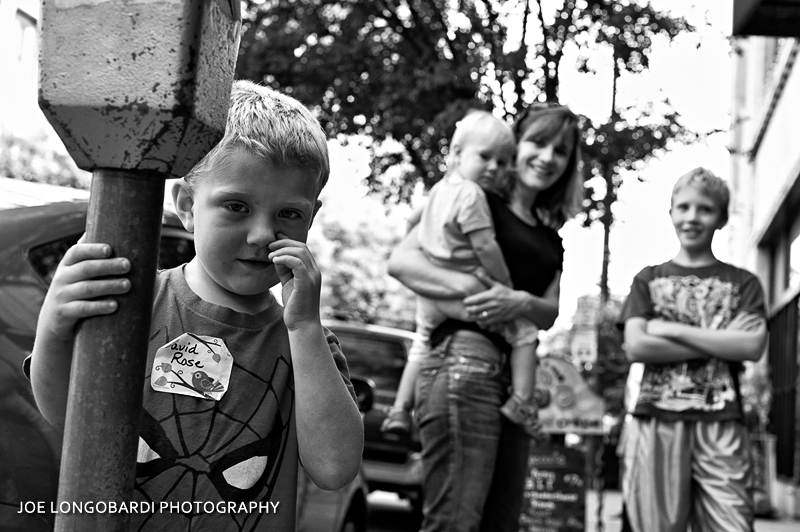
Spider-kid shot at f/8
And this is a scene shot with a 50mm from a distance. Even though I used an f-stop of 5.6, notice how much more of the scene is in focus by just stepping back.
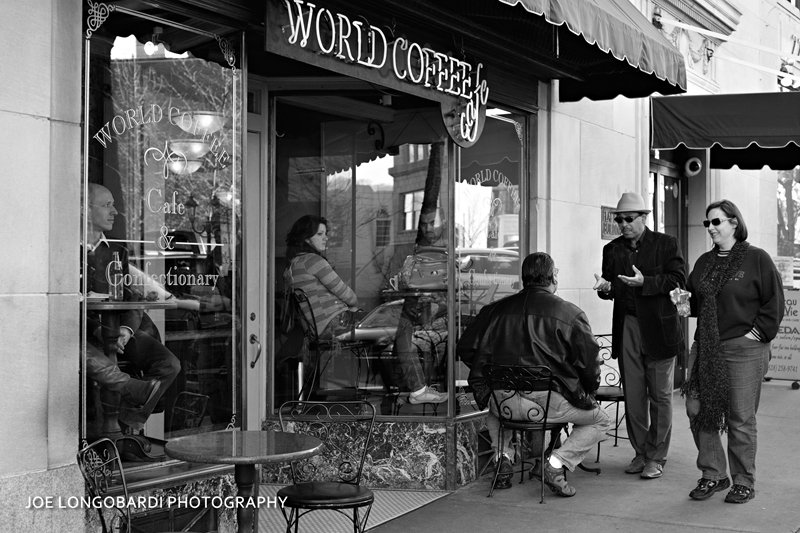
Wider scene shot from a distance using 50mm
While photographers like Winogrand moved about on narrow city streets using shorter lenses to their advantage, Bresson traveled to parts of the world that at the time were less developed and therefore less congested. And when he was shooting in more developed urban environments, they were generally in Europe and Asia that had large public squares that allowed people to move about freely, and thus affording Bresson more distance between himself and his subject. Still, Bresson did use the 50mm as a closeup portrait lens when the need did arise. And unlike the complex distortion of a 28mm lens, the inherent compression of a 50mm used up close can be very flattering.
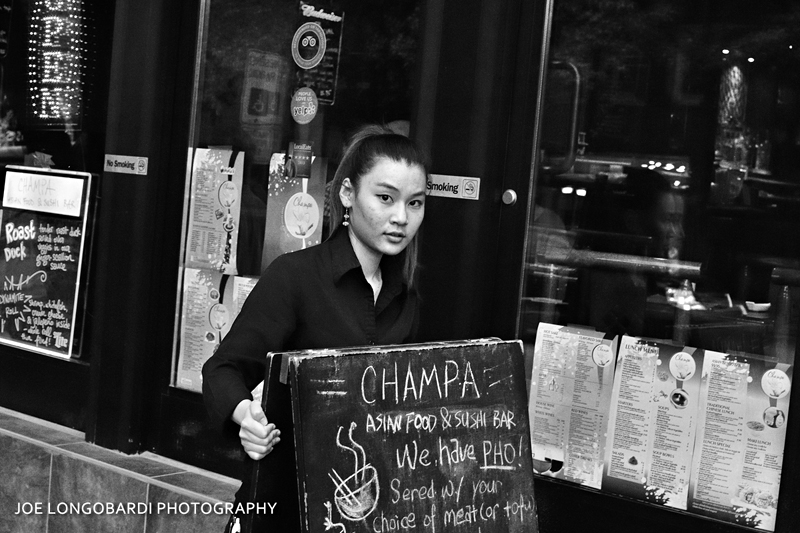
Street portrait with 50mm
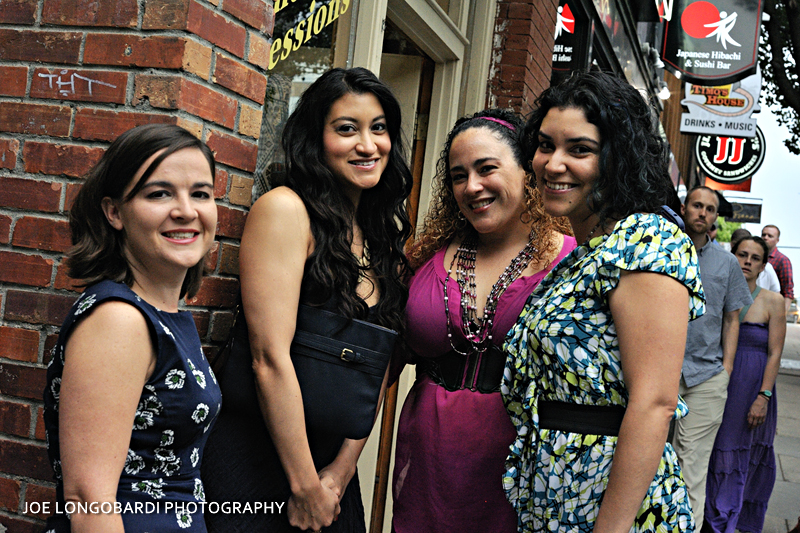
Four young women, 50mm group portrait
Included in this blog are of images that I had taken in downtown Asheville using a 50mm lens on a full frame D700. Some were taken over a period of several weeks, while thers where shot in a time span of 30 minutes. The very idea that I can take in scenes up close or at a distance offer a very short period makes the 50mm a very versatile lens for most situations. I kept my eyes open for those moments between the moments happening up close and at a distance, avoiding the trap of capturing just any pedestrian traffic that was readily available. Because so much can be happening at once, I used the 50mm at it’s full potential by zooming in at narratives either at a distance or right in front of me. In these instances, the 50mm was neither too long nor too short to capture everything I found interesting. You could experiment with a longer lens like an 85mm or even 135mm, but it will keep you far removed from the action, plus you end up having either too little room to back up or you have to shoot from across the street to get more than just a face and shoulders.
Hopefully you have found this information helpful. This is a general outline of the basic principles of utilizing the 50mm. In all, the 50mm is a very versatile lens allowing the photographer to zoom in close enough while maintaining a comfortable distance from people in public. Yet, it is short enough to get close on tight, crowded sidewalks in a busy city. One other bit of advice: Challenge yourself–find that one one lens that calls out to you and use it exclusively for a month. After a series of hits and misses, things should fall into place as you begin to understand the limits and strengths of that particular lens. No one lens works for everyone. Street photography is about seeing, and needless to say, we all see the world differently!
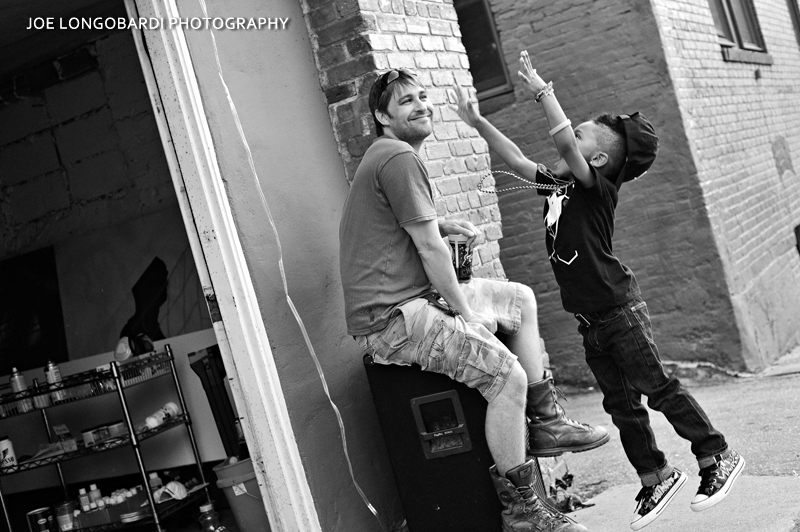
Kid jumping, captured with 50mm
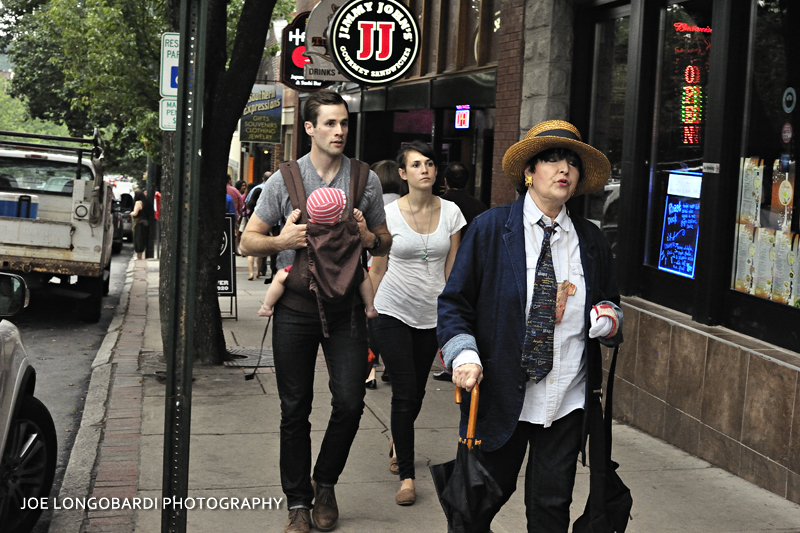
50mm used to photograph city sidewalk of downtown Asheville
I should add that I will be holding a street photography seminar on June 19, 2015 in downtown Asheville, North Carolina. It’s free and open to the public. The time is tentatively set for 5pm at the Vance Monument on Broadway and Biltmore. The intent is to offer advice via the facebook page and the actual meetup on the legalities of doing photography in a public location. We’ll also go over a few things such as copyrights and recent and past court rulings. We’ll go over the kind of lenses and cameras that work well for this genre of photography that includes the use of hyperfocusing and zone focusing to hip shooting. If you are interested, my advice is to bring along a camera and lens combination that can allow for full manual control. I will add updates on a Facebook events page on times and weather conditions as more details come together.
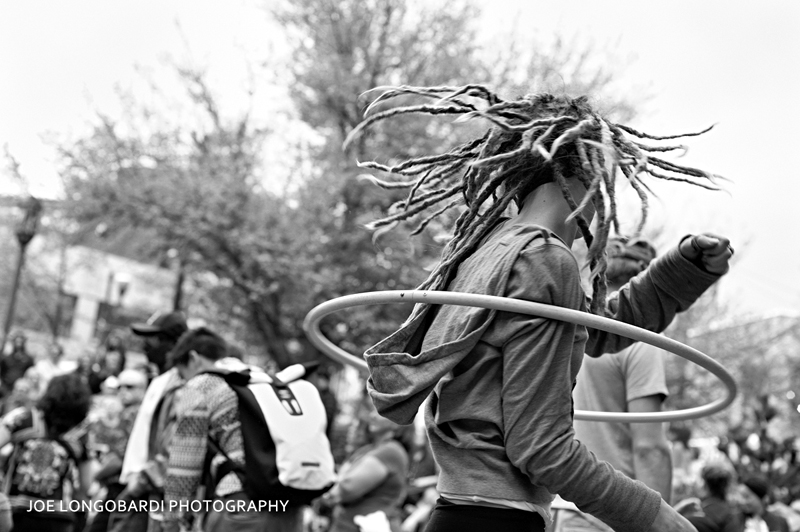
Hula Hoop in Pritchard Park
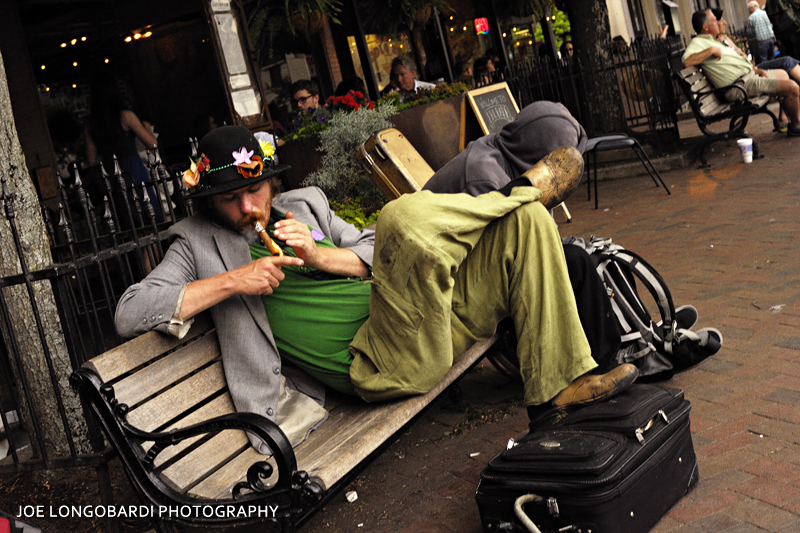
Light of a smoke

50mm up close and from the hip–not easy to do with a 50mm
All images © Joe Longobardi. All Rights Reserved.
This blog is part of a series and accompanying introduction to a street photography event that will happen on June 19, 2015 in downtown Asheville, North Carolina. For more information visit Street Photography and the Summer Solstice on Facebook.
When people think of portraiture, what generally comes to mind are classically inspired–almost painterly–uncluttered images with a pleasant, soft or out of focus background. Needless to say, this is in stark contrast to the chaotic and tumbling beauty of street photography. Yet, even contemporary street portraiture has been reduced to headshots with a long lens, the results being more about headshots than something that illustrates the personality of the individual. Much of this can been found in the plethora of “Humans of…” street projects all over the web. And there’s nothing wrong with that approach, but I find it a useful challenge to take to the streets with a short lens like a 28mm or even 24mm and look for impromptu opportunities to strike up conversations and capture not just the person, but the surrounding environment as well–a narrative, if you will! Although such wide lenses force you to get that much closer to your subject to fill the frame, and therefore resulting in more barreling due to the inherent complex distortion, used carefully, you can create some compelling images–sometimes leaving the viewer to inquire more about what happened just after the shot was taken.
Below are several photographs taken with both the 28mm and 24mm lenses. Some more candid than others. Several photos include quotes stemming from my conversations with those I photographed. What lead to them, I leave that for you to decipher.
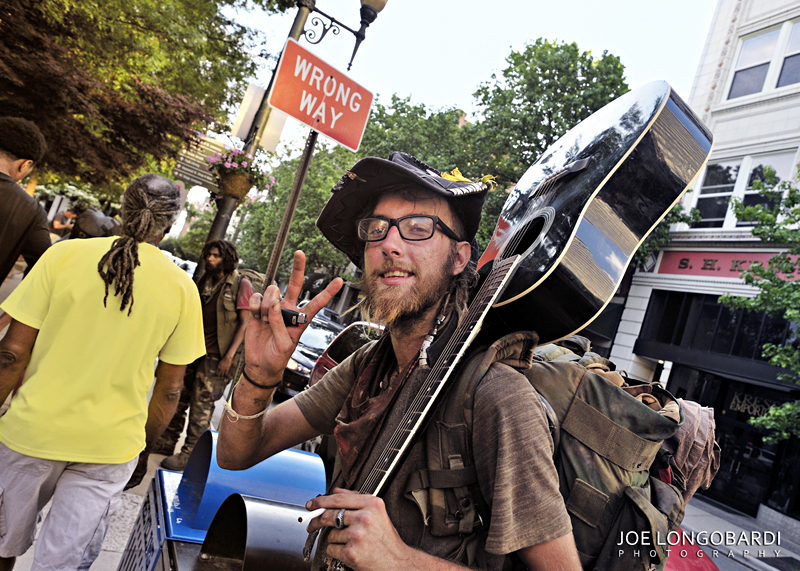
“I used to model for Esquire Magazine!” 24mm
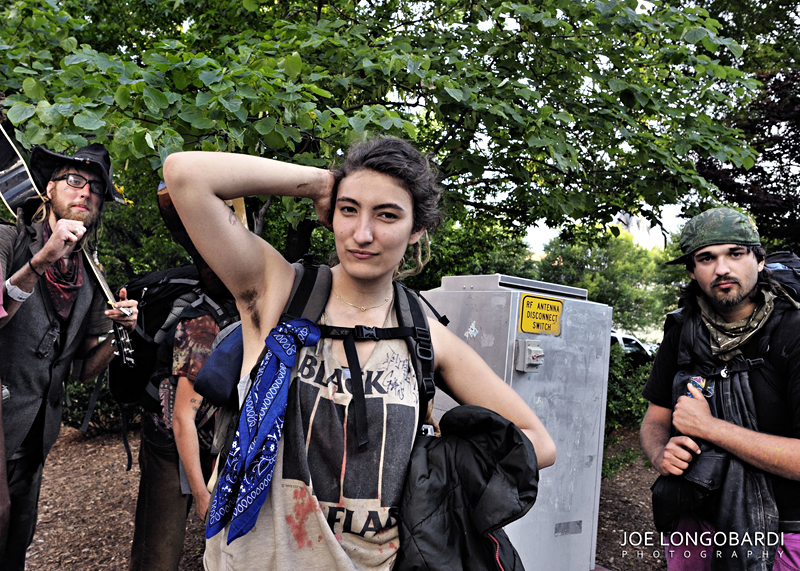
“If you’re going to take my picture, at least let me do a sexy pose for you!” 24mm.
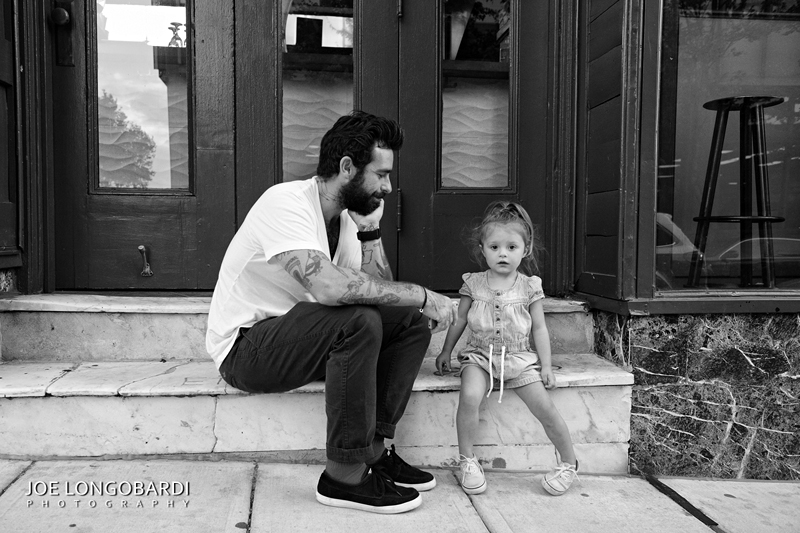
Father and Daughter. 28mm.
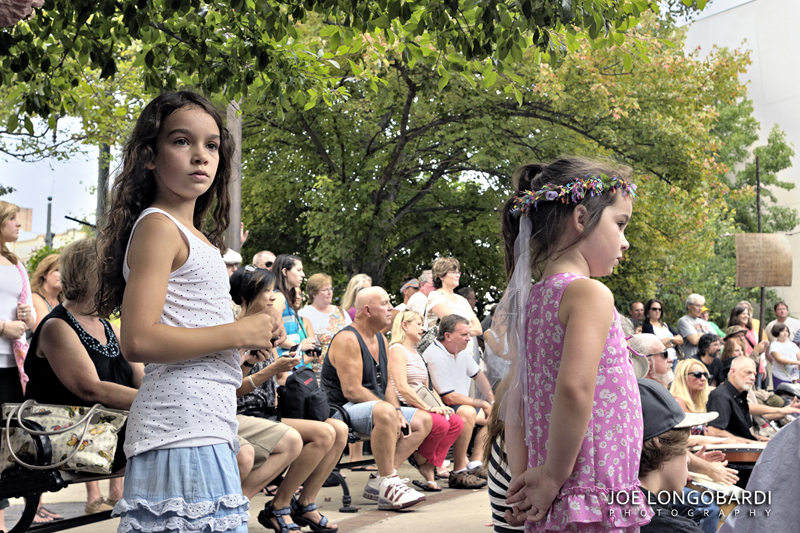
Drum Circle. 24mm.
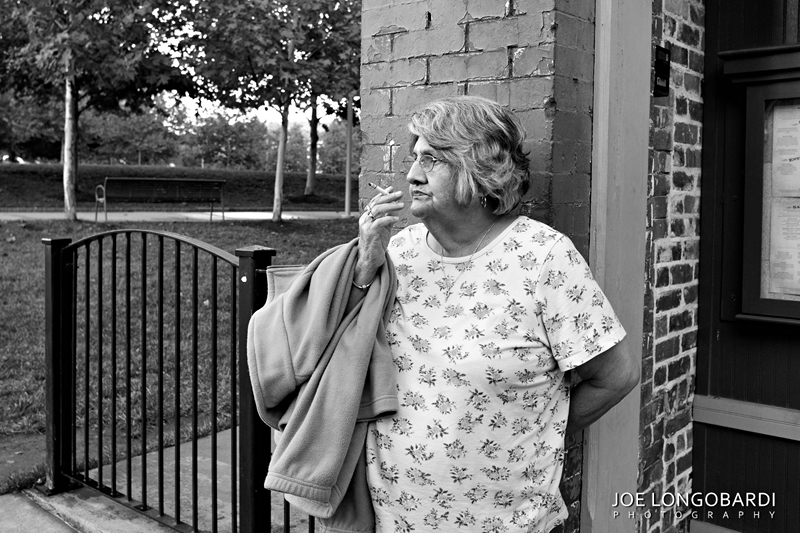
Visiting from Wisconsin. 28mm.
All images © Joe Longobardi. All Rights Reserved.
Outside opening of Asheville Symphony Orchestra performing at the Thomas Wolf Auditorium in Downtown Asheville, North Carolina.
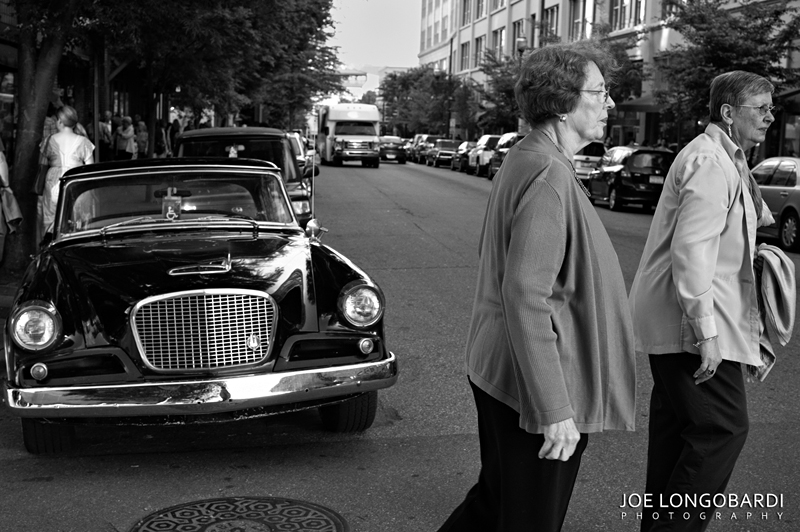
Throwback
All images © Joe Longobardi. All Rights Reserved.
April 24, 2015
This past Friday, April 24, The Asheville Buskers Collective held a music walk/demonstration beginning at 5 p.m. at the Thomas Wolf Auditorium and reaching its crescendo at an assembly and music jam just outside the facade of the Asheville Art Museum at Pack Square. Numerous performers, from musicians to living statues, attended the rally. At the final destination, artists and local supporters gave speeches touting the importance of the music community and its cultural contribution to the city of Asheville. The event was held in response to the recent crackdown by local law enforcement, and particularity by new recruits to the Asheville Police Department, targeting a number of street performers for panhandling.
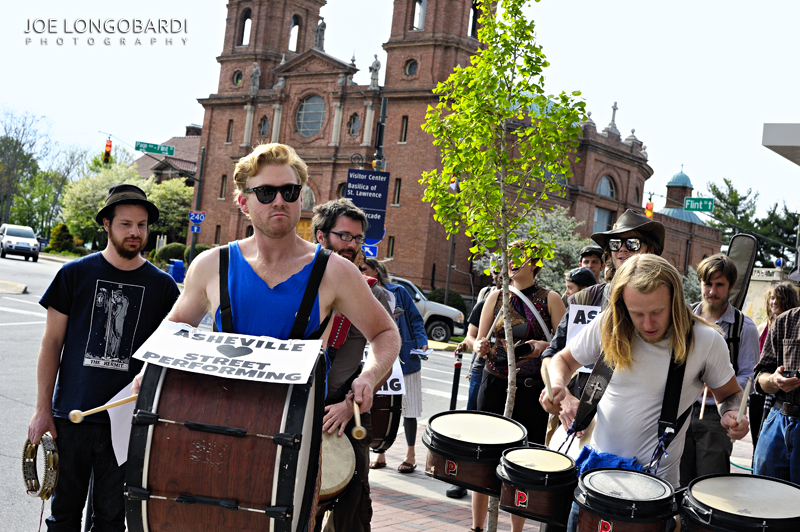
Gathering outside the Thomas Wolf Auditorium
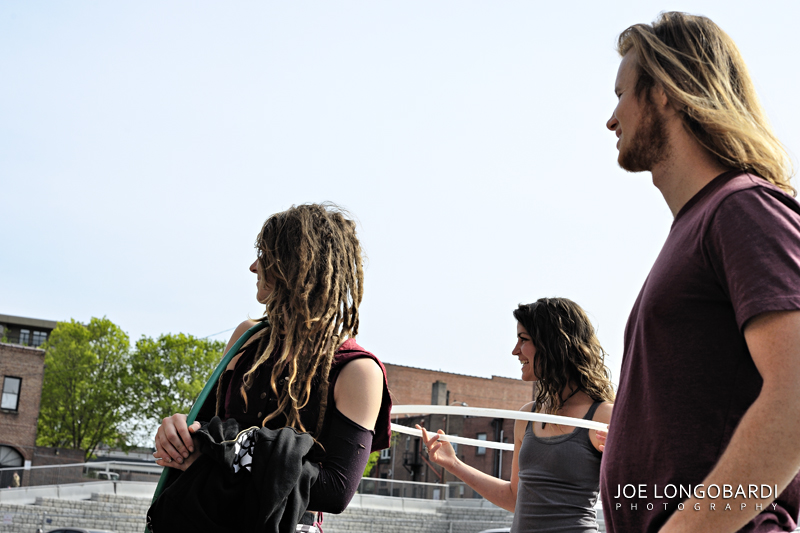
Waiting for more to arrive
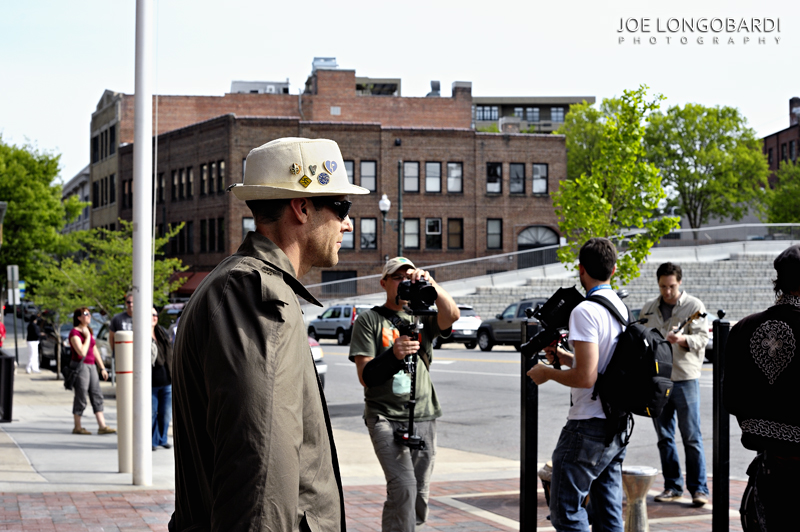
Living Statue Dade Murphy
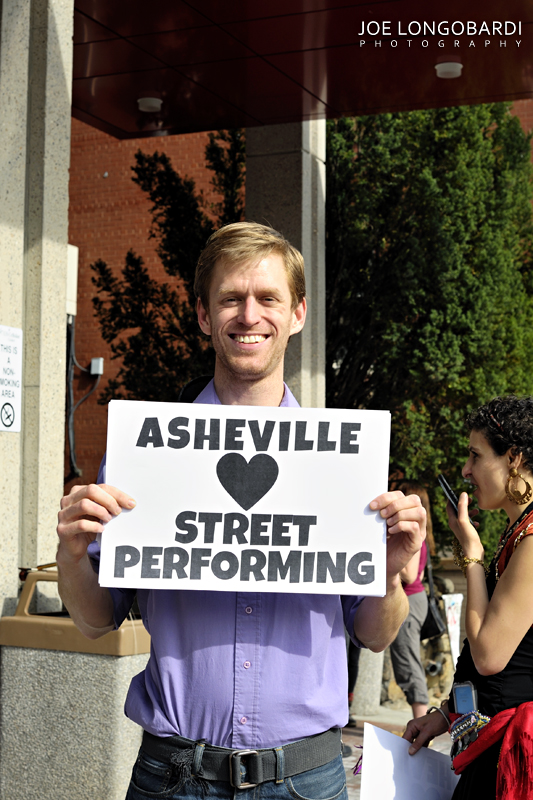
Marc Hennessey
The gathering was organized by several well established buskers that have been integral in coordinating the collective. This includes percussionist Josh Newton, violinist Marc Hennessey, and Abby Roach (Abby the Spoon Lady). They, along with others, have been in negotiations with the city in trying to establish guidelines that can bring a certain order to busking outwith the city of Asheville having to resort to establishing laws that will regulate street performances via licenses and city taxes. Even the idea of designating specific locations reeks of an overreach that would only discourage the city’s long and proud history of street performance.
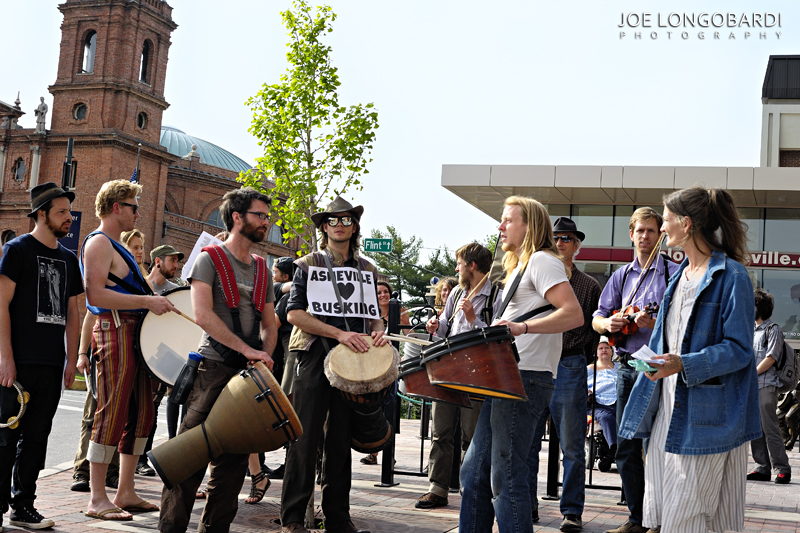
Assembling for the march
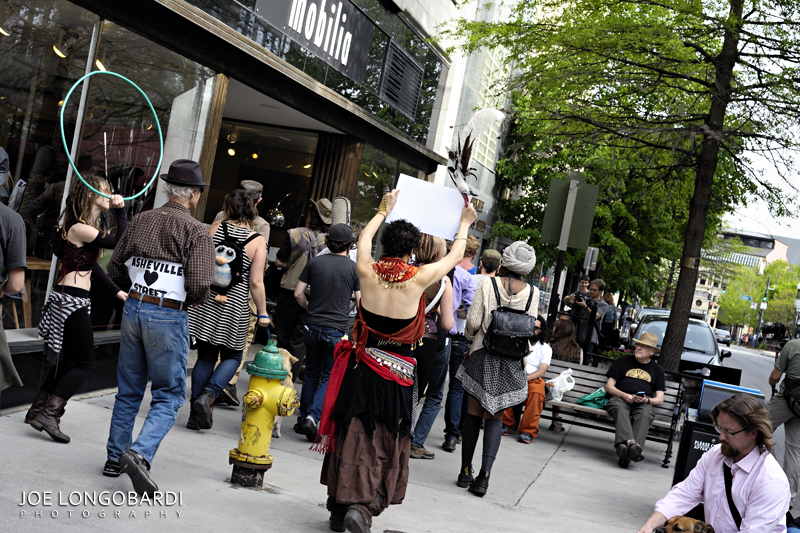
Walking down Haywood Street
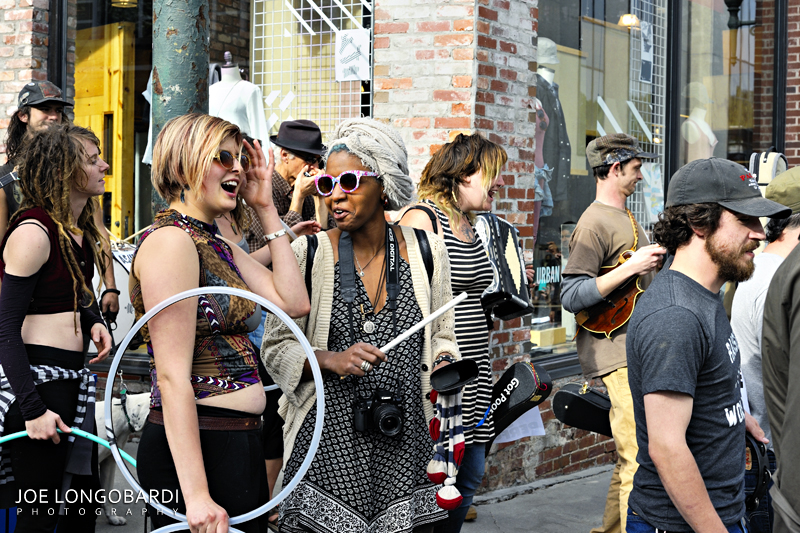
Crossing College Street
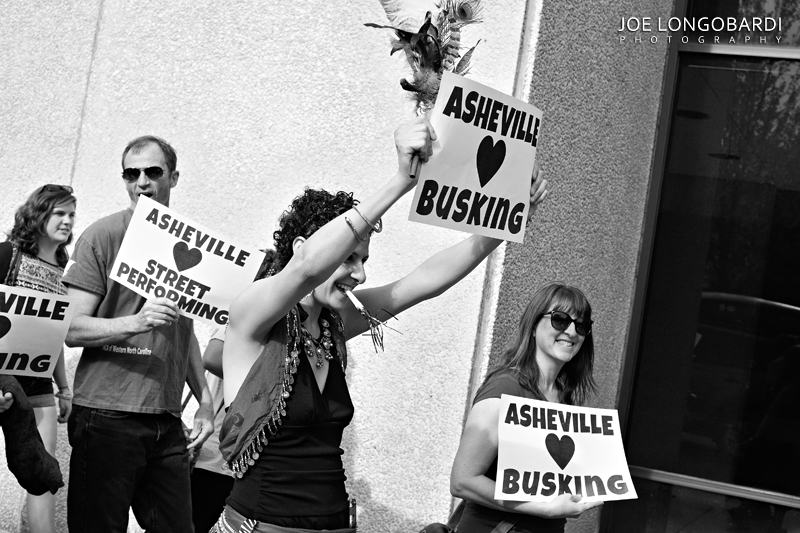
Onward to Patton Avenue
The recent implementation of the old panhandling laws comes suspiciously at a time when there have been complaints from local businesses regarding noise level and sidewalk congestion from artists performing near or in front of their establishments. This of course is not a new occurrence as there has always been a somewhat strained relationship between buskers and businesses. The recently influx of transient performers unfortunate has only created a more of a wedge between buskers and business owners.
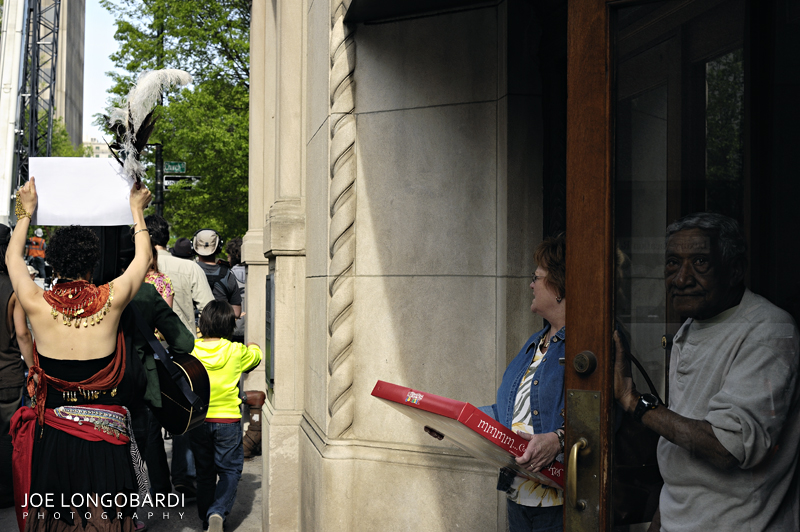
Passing through
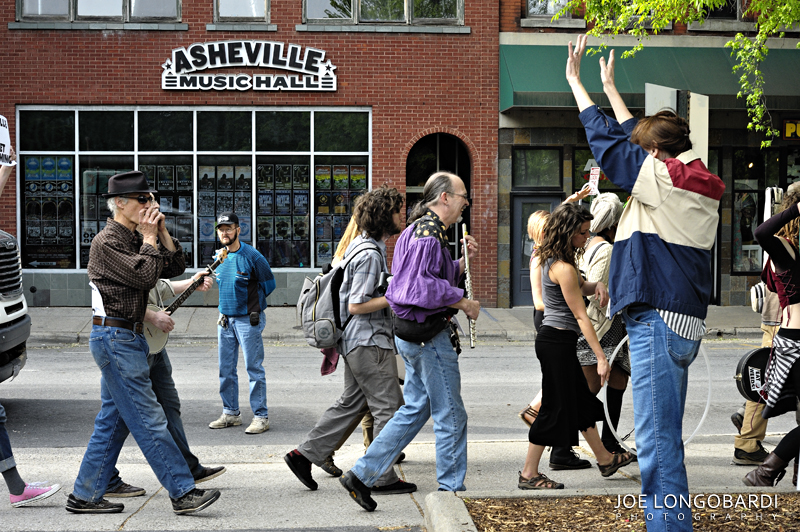
Marching down Patton Avenue
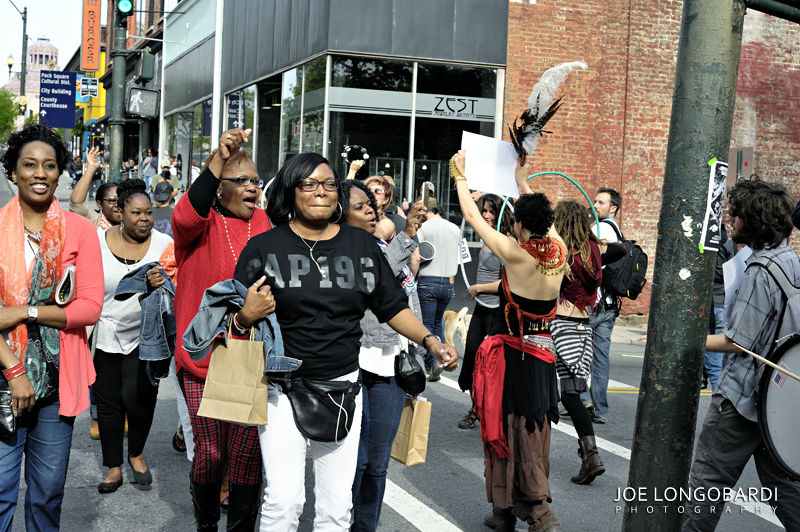
Heading toward Pack Square
But it seems to go deeper than just nuisance laws. Although buskers have always managed to sell their music CD’s while they perform, it was never legal to do so. This was generally overlooked, but because of the recent harassment by law enforcement and the transient artists that are not up to date with the protocol of being an Asheville street performer, those who have been a integral part of the scene have been bearing the brunt of recent ticket citations. And the citations are not to be taken lightly as those cited will have to appear in court. Currently, I have learned that a number of artists are no longer performing on the streets due to the recent rash of harassment, citations, and the intrusive and intimidating oversight by local law enforcement.
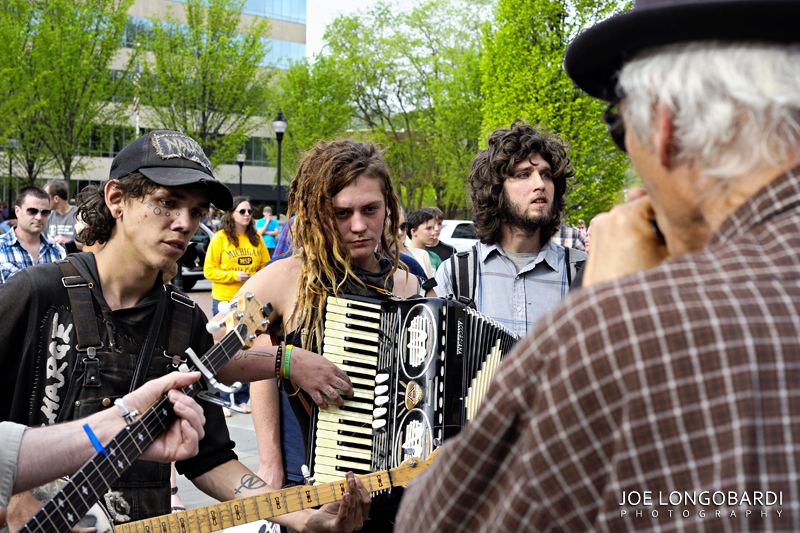
Impromptu Jam
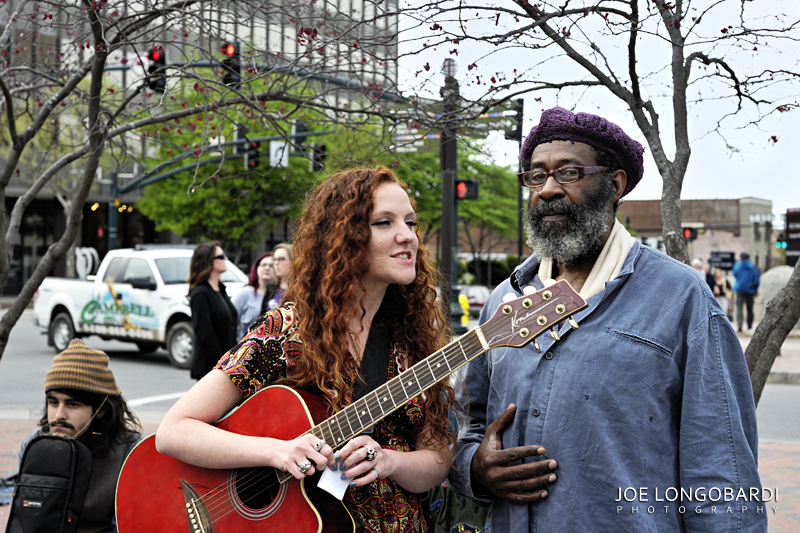
Support from locals
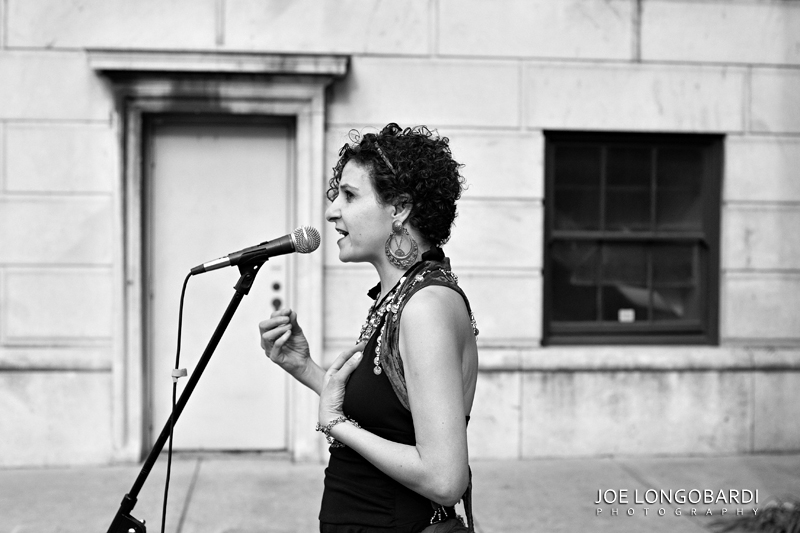
Giving speech in support of local artists
Asheville Councilman Cecil Bothwell believes that the city needs to address the “lower quality buskers” that contribute to congested sidewalks and waste matter left behind from their less than housebroken dogs in tow. I have found that any dog waste one will encounter is far from where you would find any performer and is usually the result of an inconsiderate tourist.
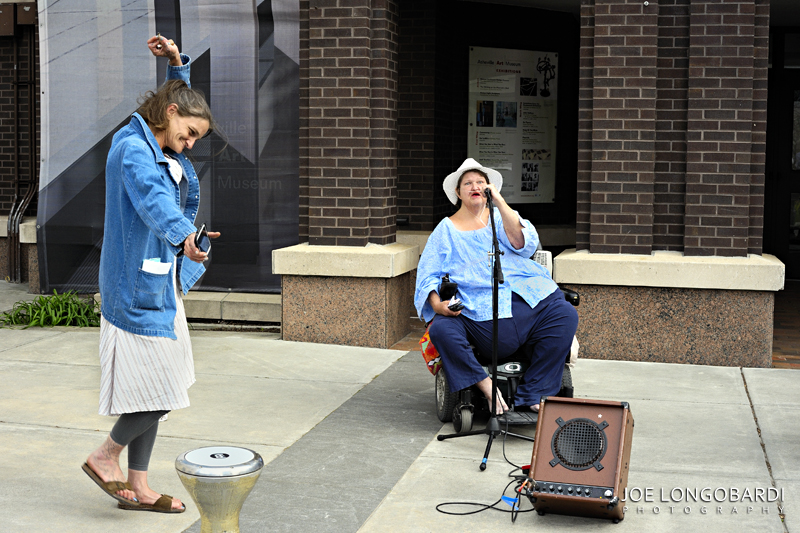
Standing up for music with Abby the Spoon Lady (left)
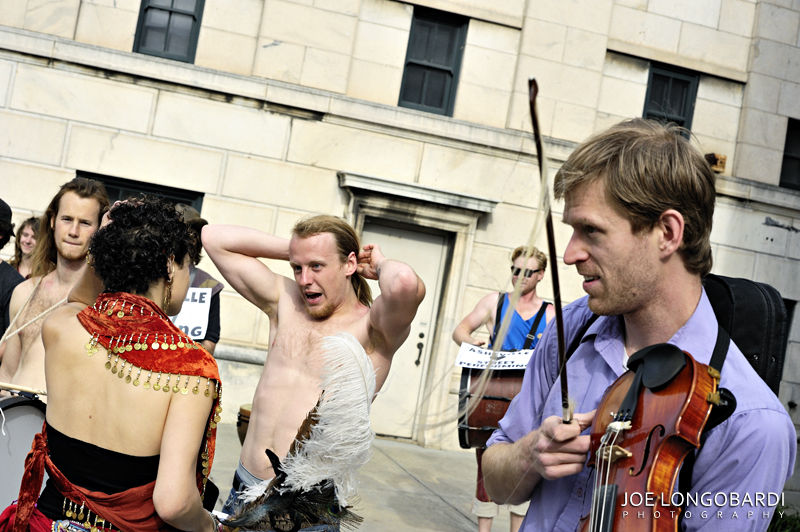
Josh Newton and Marc Hennessey
On a personal note, I have always been a big supporter of the downtown busking community. I have taken thousands of photos of local performers and those just passing through. Over the years I have made more friends in this manner than in any other time of my life. It would be a sad day when I can no longer walk down the street with camera in hand while taking in the sounds of that melding of the spiritual and mathematical that we call music. Yes, there are some artists that exhibit more ability than others. But establishing something akin to a litmus test to demonstrate one’s credibility to perform on a city sidewalk would be tantamount to elitism.
Mr. Bothwell feel’s that certain artists have greater merit than others. Orwellian undertones come to mind: “All artists are equal, but some artists are more equal than others.”
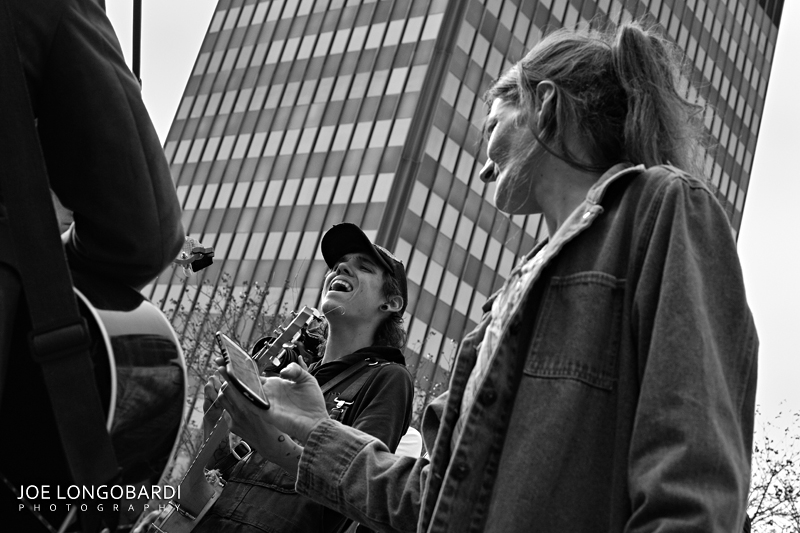
Abby the Spoon Lady
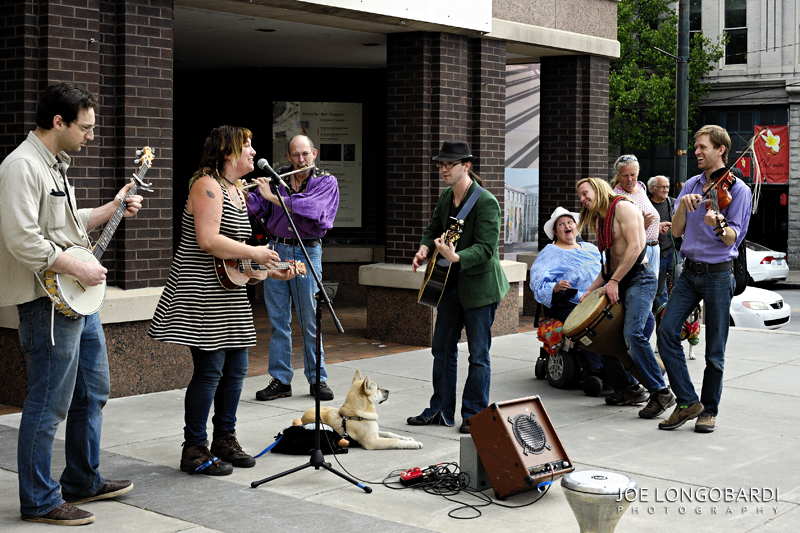
Jamming at Pack Square
The ABC and city council continue to make headway via open public meetings with the Public Safety Committee at the Municipal Building at 100 Court Plaza .
All images © Joe Longobardi. All Rights Reserved.
March 30, 2015
While taking some street photos in downtown Asheville, I ran across—well, how else can I put it? Spider-man! I had first seen the Marvel comic hero crossing College Street amidst a crowd of people. I wanted a candid shot of the unfolding scene, but he saw me aim my camera at him (he obviously had a Spidey sense of the situation). Busted, he approached me as I grabbed a quick shot of him with my film camera that I had at the moment (incidentally, it will be a little time before I get that roll developed). After taking the shot, he mentioned that if I wanted to get some more photographs of him, that he would be on the ledge of the BB&T building just across the street. I said that I may just show up there with my digital camera if he’s still in the area.
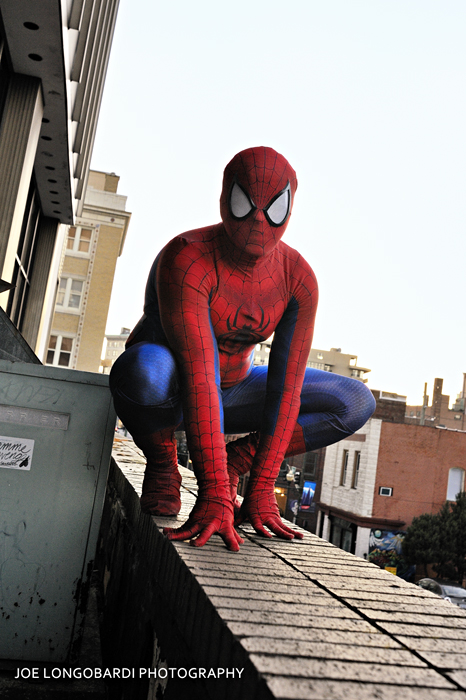
Spider-man on ledge of BB&T Building
A short time later I did retrieve my other camera and headed back to where I last encountered the wall-crawler. Off in the distance on the ledge of the BB&T building I noticed he was casting webs onto the passing pedestrians below. I soon realized that because he was so far up, that the 35mm lens that I had would not be long enough to capture anything but a wide scene, with just a hint of “Spidey” poking his head over the building’s ledge.
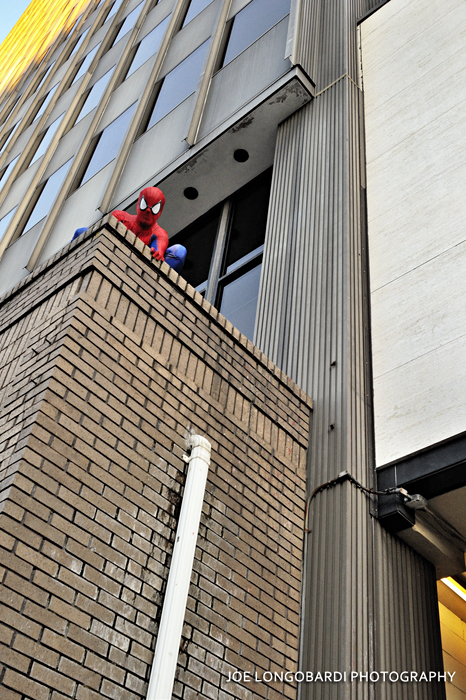
Spider-man above College Street
Well, if the mountain will not come to Mohammed (or in this case, a passable Peter Parker)…
I went around the front of the BB&T building to the level Spider-man was located, but found it somewhat prohibitive without having to crawl on the brick ledge to get in close. Our friendly neighborhood arachnid realized my vain endeavor to get in close and crawled towards me in an attempt to allow for some more intimate photos. I remarked that he didn’t have to put his life at risk just so I could get a few photographs.
Well, he was more that happy to have me capture a few moments of his time. After a number of shots of the web-slinger with the city skyline framing his masked head, he asked if I would send him a few copies via his Instagram account (peter@spideyofasheville). I assured him that I would. He eventually got off the ledge and onto more solid terrain. I showed him some of the shots on the camera screen. He said that he couldn’t really see them very well and promptly removed his mask to get a better look. I responded, “If you can’t see through that mask, how the heck are you doing this?!” He laughed. He removed his mask to reveal not just his face, but how young he was—straight out of high school!
A few more words were exchanged, and I went on my way.
I added that I would keep his identity a secret. I mean, what else would you expect from Peter Parker?
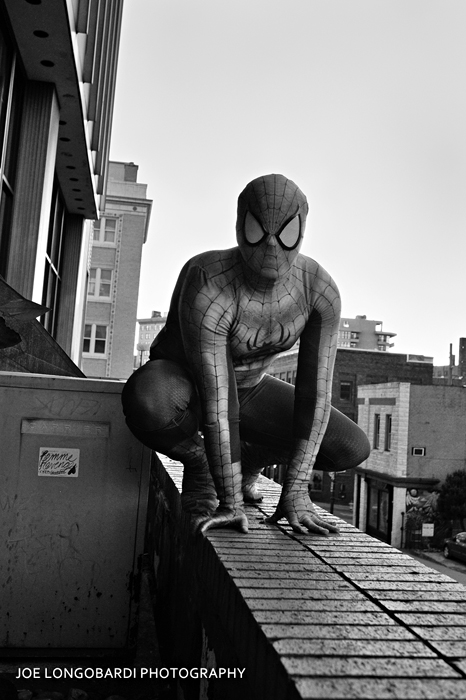
Spider-man at night
All images © Joe Longobardi. All Rights Reserved.
joelongobardiphotography.com/
joelongobardiphotography.com/books
March 17, 2015.
Saint Patrick’s Day outside the Southern Kitchen and Bar in downtown Asheville, North Carolina.
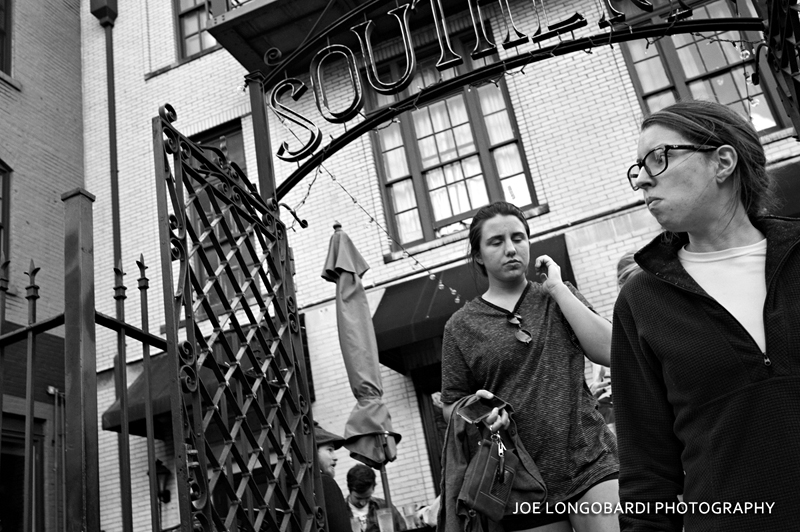
St. Patrick’s Day, Asheville, NC.
All images © Joe Longobardi. All Rights Reserved.
joelongobardiphotography.com/
joelongobardiphotography.com/books
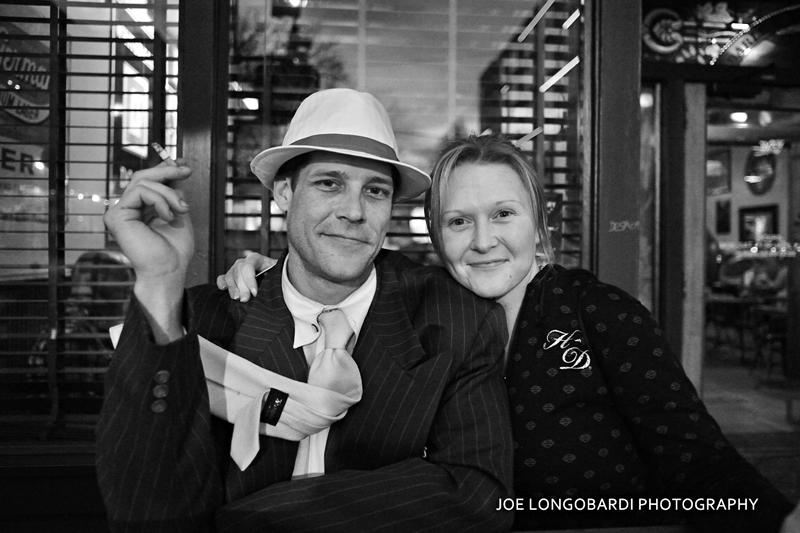
Chicago Gangland comes to Asheville
I thought I’d go back in time and share a photo that had yet to see the light of day. This is an early photo of busker Dade Murphy when he first came to Asheville in 2014 to test the waters with his then new act. If you happen stroll by the flatiron building during warmer days, you may recall his personae as the man fighting against the wind. Since this photo, he had taken his street performance to a whole new level of sophistication incorporating various props, and even a GoPro video camera hidden in his hat to record his audience’s reactions. What I particularity like about this photo is the 1920’s gangster look. Since then, Dade’s costume has become more intricate—and more disheveled! This photo was taken just after he finished his street act earlier in the day. Sadly, I do not recall the name of the woman just beside him. A number of early photos of his street performance can be found in my book documenting street performances in downtown Asheville.
All images © Joe Longobardi. All Rights Reserved.
joelongobardiphotography.com/
joelongobardiphotography.com/books
| M | T | W | T | F | S | S |
|---|---|---|---|---|---|---|
| « Feb | ||||||
| 1 | 2 | 3 | 4 | 5 | ||
| 6 | 7 | 8 | 9 | 10 | 11 | 12 |
| 13 | 14 | 15 | 16 | 17 | 18 | 19 |
| 20 | 21 | 22 | 23 | 24 | 25 | 26 |
| 27 | 28 | 29 | 30 | 31 | ||
Content © Joe Longobardi. All Rights Reserved. Powered by WordPress